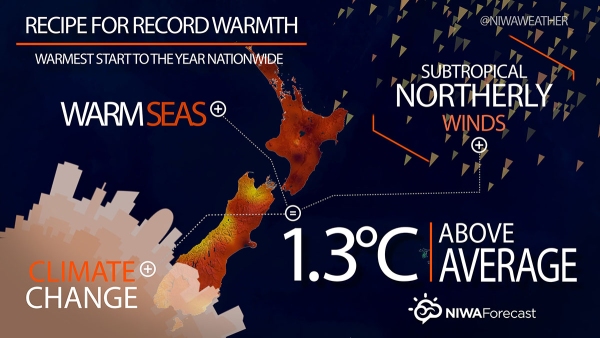The first six months of 2016 are set to be the warmest ever start to the year, according to NIWA’s long-term seven-station temperature series.
The seven-station series is a composite of long-term temperature measurements across the country, at Auckland, Masterton, Wellington, Nelson, Hokitika, Lincoln and Dunedin with records dating back to 1909.
There have been numerous temperature records broken, or nearly broken, during 2016.
Every month of the year so far (to June) has been at least 0.5°C warmer than the 1981-2010 climatological average, a record only achieved in two previous years (1971 and 1998).
Warmest May on record
NIWA climate scientist Dr Brett Mullan says February 2016, at +2.2°C above average, was the second warmest February on record (beaten by 1998); March, at +1.3°C, was the 6th warmest March; May, at +2.1°C, was the warmest May (beating the previous record holder 2011); March-April-May was the second warmest autumn, second only to 1938.
For the six-month period, January to June, the current warmest years are 1938 and 1999, tied in first place at +1.1°C, followed by 1998 (+1.0°C) and 1971 (+0.9°C).
New Zealand is experiencing June temperatures more than 1°C above average. Dr Mullan says if these mild conditions continue for the next couple of days, January-June 2016 will end up at above +1.3°C, in clear first place as the warmest first six months of the year on record. There is no possibility of a cold snap sufficiently large to push 2016 out of first place.
Why is it warmer?
The exceptionally warm conditions are a consequence of two factors – the long-term regional warming trend owing to greenhouse gas increase in the atmosphere, plus local ‘natural variability’ adding extra warming this year.
“The natural variability acts like a ‘tail wind’, pushing the local temperatures above the long-term trend. Two factors are important: sea surfaces temperatures in the Tasman Sea are exceptionally warm (persisting at more than 1°C above average since February 2016), and there has been more northerly flow than usual over New Zealand so far this year,” Dr Mullan says.
This year to year variability can be crucial in setting new records; the reason the year 1938 closely matches the more modern era temperatures is that 1938 was the most extreme year of enhanced northerly airflow since pressure records began in 1896. This year 2016 also had more northerly than normal, but nowhere near as extreme as 1938; global warming has elevated temperatures regionally such that, even with less northerly airflow, 2016 temperatures surpass those of 1938.

